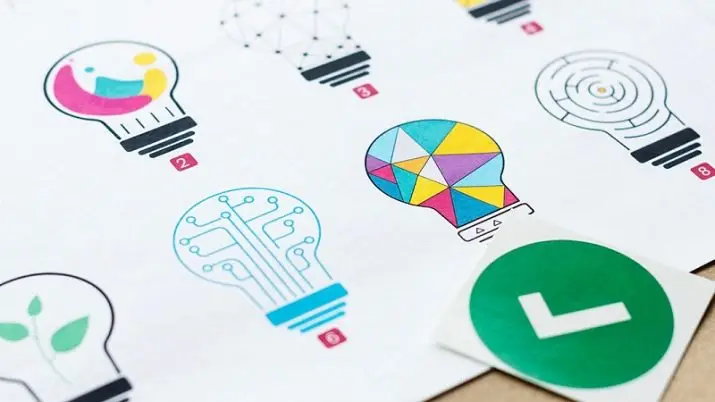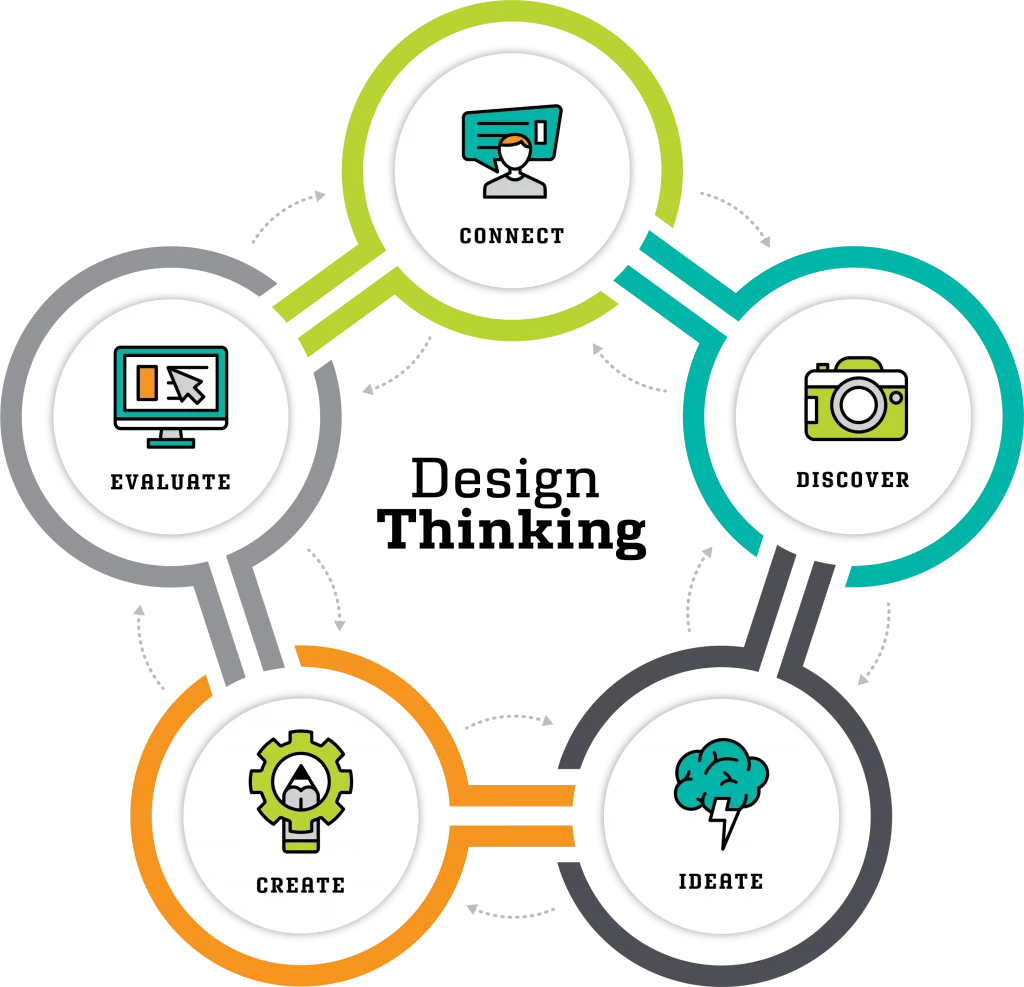Briefly about design thinking
Design thinking is a popular term used in today's design industry. It is gaining more and more popularity recently. This method is widely used to create innovative solutions, improve efficiency and user experience. Design thinking is applied in many fields, such as web design, product design, and corporate strategy.
What is design thinking? It is an approach to creating design that is based on how people think and interact with the world around them. Its main goal is to create better and more intuitive products for users. To achieve this, the process typically consists of four stages: understanding the problem, brainstorming, prototyping, and testing.
If you want to learn more about design thinking, this article is for you. In the following sections, we will consider its stages, the role of context, and practical application. Don't miss it!
What is design thinking?

Design thinking is a method used in modern design to create innovative solutions, increase efficiency and improve user experience. It is based on how people think and interact with the world around them. Design thinking is used to create better and more intuitive products for users.
The main goal of design thinking is to focus on the needs and problems of users. This approach involves four stages: problem understanding, idea generation, prototyping, and testing.
Starting with an understanding of the problem, designers analyze the context and user needs to understand what requirements the product must fulfill. This is followed by the idea generation stage, where various methods and tools are involved to create new and innovative concepts. Next, based on these ideas, a prototype is created that allows you to test the functionality and get feedback from users. At the last stage, testing is carried out, where data on the reaction of users to the prototype is collected and the necessary adjustments are made.
| Principles | Description | Usage |
| User focus | Design thinking starts with studying users and their needs. | Design thinking is applied to create products that effectively solve user problems. |
| Generating ideas | Designers generate many ideas to find the best solution to a problem. | Design thinking helps to find new innovative solutions and improve existing products. |
| Prototyping | Prototyping helps test ideas and get feedback. | Design thinking is used to create prototypes that allow you to test the product concept and identify potential problems. |
Design thinking also finds its application in various fields of design, including web design. In the field of web design, this approach helps to create user-oriented and effective websites and applications. User analytics and research is an important part of design thinking in this industry, as it allows you to understand the needs and expectations of your audience.
Next, we will look at the stages of design thinking. Don't miss it, because it will give you a concrete practical guide to applying this method in your work.
Stages of design thinking
Design thinking is a method that involves considering a problem from different angles and using non-standard approaches to solve it. This process consists of several steps that help focus on user needs and create innovative solutions.
The first stage is defining the problem. At this stage, it is important to clearly formulate the goal and identify the problem to be solved. Next comes research, where data is collected and analyzed to understand the context and needs of users. This stage allows you to get a deep understanding of the problem and find opportunities for improvement.
Then comes the stage of idea formation, where creative methods and tools are used to generate new concepts. This is an important stage where non-standard solutions are sought and a conceptual plan is created. This is followed by the prototyping stage, where a prototype of the product or service is created to test the idea and receive feedback.
Stages of design thinking
- Problem definition: Setting a clear goal and defining the problem to be solved.
- Research: Collecting and analyzing data, understanding context and user needs.
- Idea generation: Generation of creative solutions and creation of a conceptual plan.
- Prototyping: Creating a prototype of a product or service to test an idea.
- Choosing the best solution: Evaluating and choosing the best option based on the stored data.
- Solution Implementation: Development and implementation of the final product or service.
- Evaluation of results: Analysis of the effectiveness of the implemented solution and development of further recommendations.
After the prototype is made, the stage of choosing the best solution comes. All alternatives are evaluated based on the collected data in order to choose the most optimal option. The next stage is the implementation of the solution, where the final product or service is developed and implemented.

The last stage is the evaluation of the results. The effectiveness and impact of the implemented solution are analyzed in order to draw conclusions and give recommendations.
The steps can be repeated several times until the optimal solution is reached. Analytics, idea generation and prototyping are key elements of this method. This approach helps to focus on user needs and create innovative solutions.
Next, we look at the role of context in design thinking.
The role of context in design thinking
Context is important in the design thinking process because it can influence the generation of ideas and the understanding of user needs. Context encompasses a wide range of factors such as the sociocultural environment, user behavior, needs, and expectations.
One aspect of design thinking is to focus on users and their problems. And it is the context that provides the necessary foundation for this. Understanding the context allows designers to enrich their perspective and view of the problem, which leads to better and more effective solutions.
When we understand context, we can gain insights into user needs and expectations. This allows us to create products and services that best meet their needs. For example, in graphic design, context helps us understand how best to convey a certain message through visual elements. In web design, context helps create a user-friendly and easy-to-use website structure. In UI/UX design, context helps create products that best solve user problems.
Given the context, we can expand our creative zone and understand new opportunities for innovative solutions. The context gives us an outline and direction for our work, and also contributes to a better understanding of the situation and the problem with which we are working.

Advantages of Context-Aware Design Thinking
- Helps understand user needs and create products that meet them
- Maintains a focus on users and real-world problems that drive successful production and sales
- Helps create effective and user-friendly products across a variety of design disciplines, including graphic design, web design, and UI/UX design
Disadvantages of Context-Aware Design Thinking
- May require a lot of time and resources to conduct research and analyze the context
- Requires a multidisciplinary team to effectively generate ideas
- It does not always guarantee the successful implementation of ideas due to limitations of technological capabilities or budget
Next, we will look at design thinking in the context of web design. Stay tuned for more practical applications of this method in web design.
Design thinking in web design
Design thinking is a valuable tool for web designers to help create a user-friendly and efficient website structure. This approach allows you to focus on the needs of users and create products that fully satisfy them.
In graphic design, design thinking helps convey messages through visual elements. Web designers can use this method to create a user-friendly and easy-to-use website structure. In UI/UX design, design thinking is useful for creating products that effectively solve user problems.
This approach always focuses on users, not on the designer himself. Analyzing how users use a product helps to develop a better understanding of their needs and create more effective solutions.
Design thinking also helps improve communication and team collaboration. By taking into account different perspectives and ideas, it is possible to create a productive environment for working together.

Practical application of design thinking
Design thinking can have many practical applications in the real world. One of them is improving the user experience. By applying the principles of design thinking, a web designer can create a user-friendly and attractive website or application that meets the needs of users.
Design thinking also helps to optimize business processes. For example, it can be used to reduce the waiting time of customers in queues or to optimize the ordering and payment system, as Starbucks did.
Another practical field of application is the solution of complex problems. Design thinking allows you to find a new approach to fight diseases, as IDEO did in the case of diabetes.
Also, design thinking can be used in the field of training and development. For example, Stanford University has developed a Design Thinking Bootcamp course that helps students develop creative thinking and solve complex problems.
Summary: The importance of design thinking
Design thinking is a powerful tool that helps solve problems and create innovative solutions in various fields. Its importance lies in the fact that it provides a focus on the needs of users and helps to create products and services that most effectively meet their needs.
Design thinking is applied in many areas of design, including graphic design, web design, UI/UX design, and many others. It helps developers create products that are not only functionally efficient, but also convenient and enjoyable to use.
In addition, design thinking helps to improve communication and cooperation in a team. Taking into account different perspectives and ideas can create a productive environment for working together and achieving better results.
In a rapidly changing world, design thinking is a necessary tool for solving complex problems and creating innovative solutions. Using this approach, we can ensure successful business development and achieve high results in our work.
Design thinking and its application should be studied as it can be a key factor in your career and business success.
It is far from always obvious how to succeed in design. But the principles of design thinking can become your reliable guide in the world of creativity and innovation. Implement it in your work, explore new possibilities and learn from users. Then you can make a significant impact on the design world and succeed in any project you undertake.
All of this and more can be achieved through design thinking. Develop your skills, experiment and be open to new ideas. And may your design always be innovative and unforgettable!
Questions - Answers
What is design thinking?
Design thinking is a method used in various fields of design to create innovative solutions and improve user experience. It is based on how people think and interact with the world around them. This approach includes four stages: understanding the problem, generating ideas, creating a prototype, and testing it. Design thinking provides a focus on the user, facilitates communication and team collaboration, and helps create more innovative and effective products and services.
How can I apply design thinking to my work?
Design thinking can be a useful and important tool for various professional fields. Here are some tips for using it:
- Improving the user experience: By applying the principles of design thinking, you can improve the user experience of your website or application, making it more convenient and enjoyable to use.
- Optimization of business processes: Design thinking can help optimize the operation and efficiency of business processes. You can use it to reduce customer waiting time in queues or improve ordering and payment systems.
- Solving complex problems: Design thinking can be a valuable tool for solving complex problems that require a new approach. Using this method allows you to find innovative solutions and ensure successful problem solving.
- Learning and development: Design thinking can be applied in educational institutions to develop creative thinking and solve complex problems. You can use it to create interesting and effective training programs.
Applying design thinking to your work can enable more effective problem solving, improved user experience and streamlined workflows.




